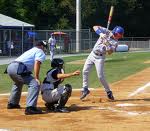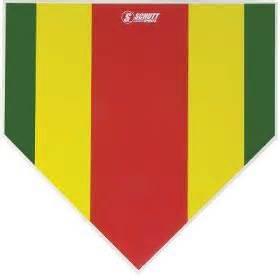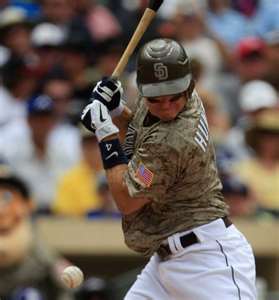Pitching Strategies - Pitching Inside
Setting Up Pitches is one of the best pitching strategies possible, and I was a big advocate of having my pitchers work the inside of the plate, as worked properly, a pitcher with a good fastball or slider, can throw an inside strike and handcuff the hitter where he either can not swing at the pitch or breaks his bat hitting the ball off the thinner handle.
Once you tie a few hitters up, the rest of the batters will have a tendency to back off the plate in order to get around on the inside fastball and that’s exactly what you want to happen, as by accomplishing this, you have made throwing a curve ball or a fastball just off the outside of the plate, extremely difficult to hit hard because the batter now has to reach for the pitch.
The same pitching strategies can be utilized for other pitches, such as if you’re a pitcher with an average fastball, give the hitters a steady diet of curve balls and off speed pitches, which will give the appearance your fastball is much faster and they either won’t be able to pull the trigger or won’t be able to get around on it.
Basic Facts: and Pitching Strategies
The measurement and shape of Home Plate has remained constant for over a 100 years, since it’s official design and shape was officially adopted by major league baseball, bear with me as I wanted to re-establish the fact that nothing physical with the plate has changed before continuing.
From a pitcher’s perspective, the entire plate area represents the legal strike zone, although it isn’t necessarily where they want to locate their pitches. I’m not saying you don’t have to throw strikes over the plate, of course you do, but the Strike - Ball count is a huge determining factor of whether you want to locate the ball over the white, or black, part of the plate.

Pitching Strategies - A Ball To The Butt Won't Hurt Too Much
Pitching strategies from pee wee league to major league level, teaches and stresses the pitcher learn to get the batter out on “Your pitch“, and your pitch is not a strike. “Your pitch” is a ball located any where around 2” to 3” off the plate and the idea is to get a batter to swing at a pitch he either can not reach, thus striking out, or can barely reach, which will induce a weak ground ball off the end of bat.
Take a look at the Colored Plate and let’s learn how to work it to your advantage:
The Red portion of the plate identifies the danger zone and pitches from the knees to the stomach should not be thrown there, however, that doesn’t mean you can’t throw a pitch down the middle.
1. A high fastball above the hitter’s hands, especially with above average velocity, but down the middle is a good Out Pitch, because although it’s easy for the hitter to see, as it’s right at eye level, it’s quite difficult to hit solidly and usually results in a strike out or pop up.
2. A curve ball thrown down the middle of the plate, knee high, is also a good Out Pitch, because the ball appears to be a pitch down the middle of the plate, but the ball will break sharply downward and off the plate, difficult to hit hard.

Pitching Strategies - Practice Hitting The Colors
The Yellow portion designates caution. This portion of the plate should normally be worked extensively early in the count in order to get ahead in the count, because although it is an obvious Strike, a majority of hitters hope to get a pitch which allows them to either drop the bat head onto the ball or fully extend their arms. This portion of the plate offers opportunities to get ahead in the count without a near automatic swing from the batter.
The Green portion of the plate, which includes an inch or two Off the plate is where you, as a pitcher, wants to dominate, showing the umpire you can consistently throw strikes in the green and you’ll get the benefit of the doubt on close pitches, which means the difference between a 3-2 count vs. a strike out.
Wrong Strategies - Different Mentalities:
Although home plate measures 17” across at it’s widest part, Pitchers 20 years ago could claim ownership and pitch to a Home Plate measuring 19” to 21” wide, as they considered 2” off the plate on either side also their territory, while pitchers of today throw at a Home plate 14” to 17” wide, which the loss of those 4 inches have kept many pitchers in the minors from making it to the major leagues.

Pitching Strategies - Moving Them Off The Plate
Why the difference? Because pitchers of today are afraid to pitch inside, losing the additional legal 2” of plate, the unofficial 2” off the plate, and possibly worse of all, suffering a huge tactical and mental disadvantage.
As a hitter, if I know the pitcher will not throw a pitch inside on my hands, I can move closer to the plate, which allows me to make solid contact with the pitch 2” off the plate, instead of swinging and missing.
Why are pitchers afraid to throw inside? Because major league hitters have become whiners and cry babies and have forced an environment, with the umpires’ assistance, if a pitcher throws inside, he’s trying to hit the batter.
As everything is influenced by the major leagues, it’s an unavoidable trickle down effect that little league pitchers can not throw inside.
Historic Strategies: Different Times
Twenty years ago batters were accidentally hit as they are today and nobody thought anything about it. However, there were many pitchers, Bob Gibson was one, who didn’t try to hide the fact he was throwing at you, but never without good reasons for pitching “Far” inside.
1. If a hitter stood too close to the plate, he’d squeeze the strike zone on the pitcher, making it smaller and gaining an advantage over the pitcher. The pitcher threw Inside in order to move the batter back off the plate and regain, what he considered, his additional 2”.
2. If a hitter took an extraordinary amount of time or effort digging in at the plate, sending an obvious visual signal to the pitcher he was preparing to tee off on a pitch. ( A sign of disrespect ) The pitcher simply loosened him up and forced him out of his dug in position, by throwing inside. Nothing will stop a hitter from Digging In quicker than a hummer under the chin.
3. The inside pitch was occasionally used as a “display pitch.” Much like a pitcher who has difficulty throwing a curve ball, he still throws the pitch, not really intending to throw it for a strike, in order to put the fear or question in the hitter’s mind he may have to contend with hitting a curve ball.
4. There is of course the final reason. Call it Pay Back, Restitution or a Penalty for embarrassing the pitcher or showboating. For instance, in the past, if a batter hit a home run, dropped his bat and gingerly ran around the bases, it was considered “no harm…no foul.”
However, if the batter stood at home plate admiring his home run, slowly trotted around the bases or smiled at the pitcher as he rounded the bases… he’d better be prepared to take a pitch to the ribs the next time he batted.
Ironically, occasionally the next batter, who had nothing to do with the home run, also endured the wrath of an angry pitcher by taking a fastball under the chin. There was a respect issue there that no longer exist today.
We’ve actually covered a lot of ground here, from history to strategy to purposes of pitching inside to hitters.
Although I’d never condone, nor teach the action of purposely hitting a batter, I do believe in the pitcher throwing inside. It’s part of the pitching zone, it’s a tactical advantage and it’s an excellent pitching strategy. If you don’t teach your pitchers the intent and advantage of pitching inside, you’re doing them a great disservice.
Pitching Strategies Back To Learn to Pitch

New! Comments
Have your say about what you just read! Leave me a comment in the box below.